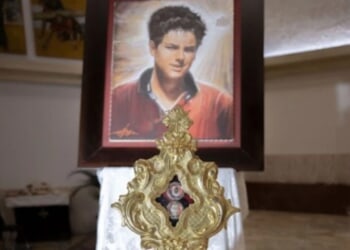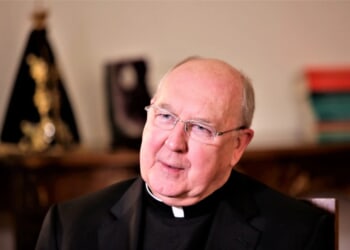One of my favorite Bob Dylan songs is “Tangled Up in Blue,” in part because of this set of lines, both literary and spiritual:
She lit a burner on the stove
And offered me a pipe.
“I thought you’d never say hello,” she said,
“You look like the silent type.”
Then she opened up a book of poems
And handed it to me,
Written by an Italian poet
From the thirteenth century.
And every one of them words rang true
And glowed like burnin’ coal,
Pourin’ off of every page
Like it was written in my soul from me to you.
Tangled up in blue….
The Italian poet that Dylan referred to is Dante. He gave us a masterpiece, his La Divina Commedia (The Divine Comedy), with three unforgettable sections: Inferno, Purgatorio, and Paradiso.
And if you want more insights into Hell, Purgatory, and Heaven, especially this Holy Week, I commend the words of an Italian mystic from the 14th century. Her name is Saint Catherine of Siena. And her words speak to me and you — to the world of her day and especially ours today. (RELATED: The Holiest Week)
Mystic, Doctor of the Church, Inspiration to Popes
Catherine of Siena is one of the most remarkable figures in the history of Christianity. Along with Theresa of Ávila, she was named by Pope Paul VI as one of the first female doctors of the Roman Catholic Church. The “doctor” designation means “teacher,” which was appropriate given Catherine’s nearly 400 letters, 26 prayers, plus her famous Dialogue. Pope Pius XII made her co-patron of Italy, along with Saint Francis, and Pope John Paul II made her a co-patron of Europe.
Caterina Benincasa was born in the lovely Medieval city of Siena on March 25, 1347. Her mother, Lapa, was nearly 40 years old when she gave birth to Catherine and a twin sister, Giovanna. Giovanna and Catherine were, respectively, Lapa’s 23rd and 24th children, most of whom did not survive infancy.
Catherine’s parents immediately saw her unique spiritual gifts, including profound visions that the mystic experienced at a young age. But despite these gifts, they insisted upon marriage for her, as was the custom for young women of the day. Catherine fought against it, cutting her attractive long hair to try to degrade her appearance. Eventually, her parents relented, seeing the striking depth of the girl’s obvious gifts.
Around age 16, Catherine joined a group of penitent Third Order Dominican laywomen who called themselves the Mantellate. The word translates into “cloak” or “cape,” their distinctive form of dress: a black mantle or cape over a white habit.
Catherine’s spiritual works and astounding displays of holiness were witnessed by all. She soon had the attention of popes, even boldly urging the pontiffs of her day to leave their current displaced home in Avignon, France, and return to Rome, the home of St. Peter, the true seat of the papacy. She steeled their waning courage. The respect and even fear that this humble, demure, but strong Medieval woman struck in the popes was astonishing.
For moderns who today want to argue that the Catholic Church has long repressed and not listened to women, they should educate themselves about Saint Catherine of Siena.
‘Lived Theology’ and ‘Disordered Love’
A key element of what John Paul II called her “lived theology” is that Catherine emphasized the imperative to have correct knowledge of the truth. She said that defective knowledge of truth leads to sin. Like Dante Alighieri, who lived about a hundred years before Catherine, she taught that sin often comes from loving the wrong things. Yes, you must love, but your love must be properly ordered. Above all, you should not love sin.
Love your neighbor, but not your neighbor’s sin.
Our Western world today is replete with disordered love, with people loving the wrong things. That includes disordered sexual expressions of love. Catherine saw it in her day as well, including among clergy who were supposed to be sexually pure.
What Catherine had to say about that is recorded in her masterwork, The Dialogue. The book is a dictated transcript, including God the Father’s response — yes, God Himself — to various questions from Catherine.
Being a saintly person, Catherine took no pride in this divine gift. Pride, after all, is the first and worst of the Seven Deadly Sins. You don’t celebrate Pride. And just in case she had any such temptation, the Lord told her explicitly: “Do you know what you are to Me, and what I am to you, my daughter? I am He who is. You are she who is not.”
Catherine knew her place. She referred to herself as “I Caterina, humble servant.” And that servant was gifted with the charism of prophecy in order to warn others, especially wayward priests. The Dialogue is packed with admonitions to clergy.
To that end, a series of particularly striking messages that Catherine received in the 14th century can be applied acutely to our time, though they’re so politically incorrect that modern censors have excised them from her classic treatise. What the courageous little Italian gal said about sexual corruption is so shocking to modern ears that editors have committed the sin of omission of removing those sections entirely — something they may need to explain face to face some day to God the Father. (One needs to track down older editions, namely chapters 110-134, to find these passages.)
I must be very careful here about quoting those sections. Doing so will get this website further blacklisted by cancel culture and the self-proclaimed apostles of “tolerance” who hate free speech that disagrees with them. (I quote the sections in the chapter on Catherine in my book The Stigmatists.) But I will say here that Catherine, relaying the words of God Himself, lamented that too many priests, committed to serving their flock in persona Christi (in the person of Christ), had become “infected” by “impurity” and “the poison of sin.” This sin was such an “abomination” and “stench” that it “displeases” even the demons. This “enormous sin” repulsed even “the devils” because their nature was originally angelic, and that angelic nature prompted them to recoil in disgust at this act against nature. The demons might well lead the sinner to perdition, but when the victim goes forth with the actual commission of the sin, the demons flee the scene; they cannot bear to watch.
Catherine said that God told her that this “sin against nature” was so abominable that for it alone He destroyed no less than five cities.
Yes, shocking stuff for today’s woke.
For guilty priests, this sin not only “darkened the light of their intellect” but also their ministry. They “minister in darkness.” God told Catherine: “How can these men full of such terrible sins do justice to, or reprove the sins of their subjects? They cannot.”
This brings us back to the matter of “disordered” affections. Such misplaced desires, even if done as an expression of “love,” are wrong. (Dante also wrote about this. He had a circle of hell for those guilty of this misplaced love. Click here for an excellent piece by Rod Dreher.)
Catherine said that God told her that these priests are filled with “inflated pride.” They are “not rightly ordered, but rather corrupted with self-love and pride, and their reins are full of impurity; for they desire to fulfil their disordinate delights.”
The degree to which Catherine’s message speaks to today needs no explication at all. The sexual abuse crisis among Catholic clergy is the modern scourge of the Church. Let it be said that we were warned long ago by Catherine of Siena.
Prophet for Our Times
There are many ways that Catherine of Siena, centuries ago, spoke to our times.
And yet, though the Church and world might be falling apart, St. Catherine placed her hope in God the Father and His Son, Jesus Christ. After all, before the Resurrection, there had to be a Crucifixion. No cross, no crown. There had to be the sadness of Good Friday before we could have the risen glory of Easter Sunday.
Catherine’s influence in her lifetime was profound, even given her short time in this world. She died in Rome on April 29, 1347. Like her Savior, she was 33 years old when she succumbed after a period of intense suffering, offered up for the world’s sins. She had given everything. She famously urged: “Be who God meant you to be and you will set the world on fire.”
These were just some of the remarkable words of this Italian mystic of the 14th century. They are words which, to borrow from Bob Dylan, ring true and burn from her every page, written in her soul from me to you — to her world centuries ago and to ours still today.
READ MORE from Paul Kengor:


![NYC Tourist Helicopter Falls into Hudson River, Siemens Executive and Family Among Those Killed [WATCH]](https://www.right2024.com/wp-content/uploads/2025/04/NYC-Tourist-Helicopter-Falls-into-Hudson-River-Siemens-Executive-and-350x250.jpg)






![Green Day’s Cringe Trump Diss Ends in Fire and Evacuation [WATCH]](https://www.right2024.com/wp-content/uploads/2025/04/Green-Days-Cringe-Trump-Diss-Ends-in-Fire-and-Evacuation-350x250.jpg)
![Red Sox Fan Makes the ‘Catch of the Day’ with Unconventional ‘Glove’ [WATCH]](https://www.right2024.com/wp-content/uploads/2025/04/Red-Sox-Fan-Makes-the-‘Catch-of-the-Day-with-350x250.jpg)
![Bikini Clad Spring Breakers Prove Our Education System is Failing Students [WATCH]](https://www.right2024.com/wp-content/uploads/2025/03/Bikini-Clad-Spring-Breakers-Prove-Our-Education-System-is-Failing-350x250.jpg)





